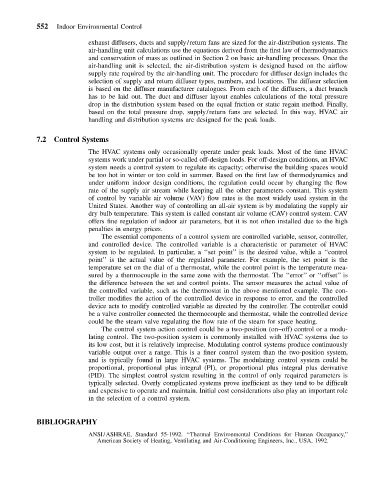Page 563 - Mechanical Engineers' Handbook (Volume 4)
P. 563
552 Indoor Environmental Control
exhaust diffusers, ducts and supply/return fans are sized for the air-distribution systems. The
air-handling unit calculations use the equations derived from the first law of thermodynamics
and conservation of mass as outlined in Section 2 on basic air-handling processes. Once the
air-handling unit is selected, the air-distribution system is designed based on the airflow
supply rate required by the air-handling unit. The procedure for diffuser design includes the
selection of supply and return diffuser types, numbers, and locations. The diffuser selection
is based on the diffuser manufacturer catalogues. From each of the diffusers, a duct branch
has to be laid out. The duct and diffuser layout enables calculations of the total pressure
drop in the distribution system based on the equal friction or static regain method. Finally,
based on the total pressure drop, supply/return fans are selected. In this way, HVAC air
handling and distribution systems are designed for the peak loads.
7.2 Control Systems
The HVAC systems only occasionally operate under peak loads. Most of the time HVAC
systems work under partial or so-called off-design loads. For off-design conditions, an HVAC
system needs a control system to regulate its capacity; otherwise the building spaces would
be too hot in winter or too cold in summer. Based on the first law of thermodynamics and
under uniform indoor design conditions, the regulation could occur by changing the flow
rate of the supply air stream while keeping all the other parameters constant. This system
of control by variable air volume (VAV) flow rates is the most widely used system in the
United States. Another way of controlling an all-air system is by modulating the supply air
dry bulb temperature. This system is called constant air volume (CAV) control system. CAV
offers fine regulation of indoor air parameters, but it is not often installed due to the high
penalties in energy prices.
The essential components of a control system are controlled variable, sensor, controller,
and controlled device. The controlled variable is a characteristic or parameter of HVAC
system to be regulated. In particular, a ‘‘set point’’ is the desired value, while a ‘‘control
point’’ is the actual value of the regulated parameter. For example, the set point is the
temperature set on the dial of a thermostat, while the control point is the temperature mea-
sured by a thermocouple in the same zone with the thermostat. The ‘‘error’’ or ‘‘offset’’ is
the difference between the set and control points. The sensor measures the actual value of
the controlled variable, such as the thermostat in the above mentioned example. The con-
troller modifies the action of the controlled device in response to error, and the controlled
device acts to modify controlled variable as directed by the controller. The controller could
be a valve controller connected the thermocouple and thermostat, while the controlled device
could be the steam valve regulating the flow rate of the steam for space heating.
The control system action control could be a two-position (on–off) control or a modu-
lating control. The two-position system is commonly installed with HVAC systems due to
its low cost, but it is relatively imprecise. Modulating control systems produce continuously
variable output over a range. This is a finer control system than the two-position system,
and is typically found in large HVAC systems. The modulating control system could be
proportional, proportional plus integral (PI), or proportional plus integral plus derivative
(PID). The simplest control system resulting in the control of only required parameters is
typically selected. Overly complicated systems prove inefficient as they tend to be difficult
and expensive to operate and maintain. Initial cost considerations also play an important role
in the selection of a control system.
BIBLIOGRAPHY
ANSI/ASHRAE, Standard 55-1992. ‘‘Thermal Environmental Conditions for Human Occupancy,’’
American Society of Heating, Ventilating and Air-Conditioning Engineers, Inc., USA, 1992.

